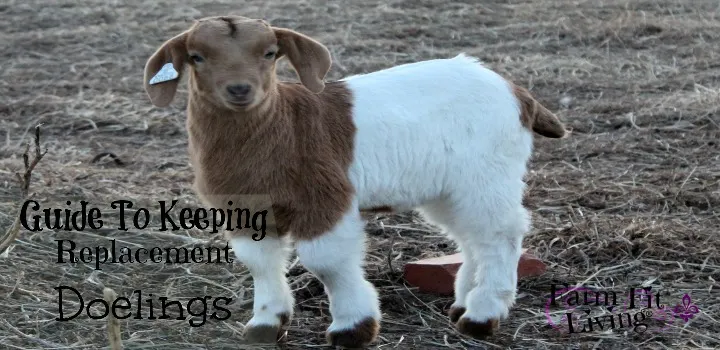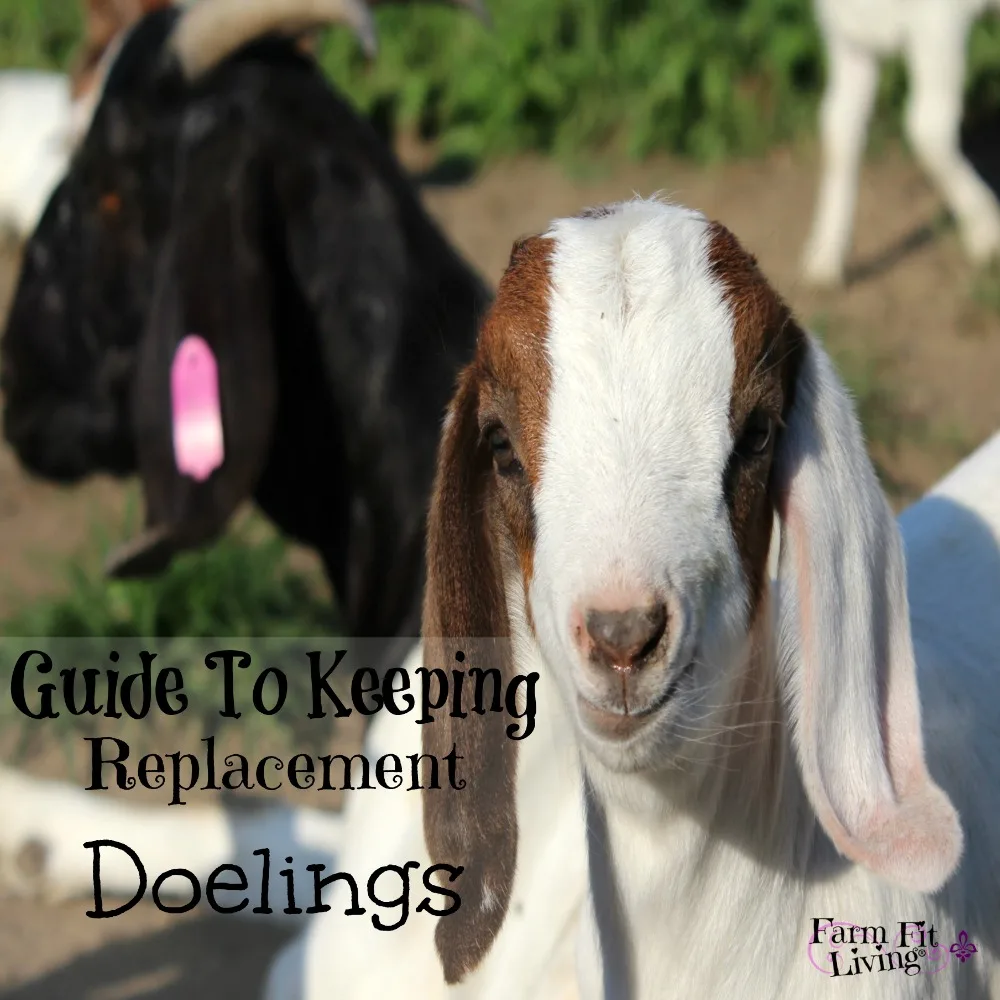Are you considering keeping replacement doelings back into your meat goat operation?
Keeping replacement doelings require a standard set by you as a producer based on your production goals.
Many producers of all species have found that raising and keeping their own breeding stock can have many more benefits than purchasing new breeding stock each year.
The same can definitely be said for breeding meat goat doelings.
In fact, very few of the does I have purchased for my goat operation have performed in the way that was promised to me. I have had much better luck raising and breeding my own doelings.
One of the reasons I prefer replacements is because I can keep my herd closed and diseases out. My herd has grown much faster due to this practice. I’m able to keep 15-20 healthy doelings back into my herd each year without culling out very many.
I find my operation inching closer towards the goals I set thanks to the practice of keeping replacement doelings.
Long-term goals
All producers should have good long-term goals they want accomplish with their operation. Producers without goals do not have anything to work towards. Their path is short and often sort lived.
Make some long term goals that are designed for you and your operation to thrive. Not just survive.
My own long term goals are to produce a quality meat goat that will top the markets. I must choose to keep the type of genetics that will grow well but also perform structurally.
To make it easier on me as a producer, I want my herd full of great mothers who can produce multiple kids. The kids born to these mothers include young does I will plan to keep back to continue to grow my herd.
There is a protocol to meeting the standards set by you to meet your long term goals. It’s up to you and where you want to go with your operation. To meet my long term goals, there are a few guideline points I look for when choosing to keep replacement doelings.
Structure
The way an animal moves designates how the animal will perform. How the animal is made is the first quality point I look for in a replacement doeling.
Think of the animal like a puzzle. All the pieces of that animal have to fit together into one solid block that moves and flows together.
If a piece is missing from the puzzle, such as lacking in bone or poor shoulder structure, the animal may not be able to perform for you as long as you’d like.
I expect my animals to browse and graze long distances during the grazing season. They need to be able to walk throughout the pasture and especially run from predators or weather conditions. I look for good feet and leg structure with plenty of bone in the forearm. I also like a good doe that is wide based with plenty of length and depth of rib.
These are standards I select for. You may be looking at other structural qualities first. One thing is for sure: The animal must be able to move and perform in the way it was made to do.
While one selection point is structure, the next point is how hardy the doe should be based on past grand genetic performances.
Hardiness
I’m talking about things like parasite resistance when I discuss hardiness. I have a distinct spot treatment protocol when treating for parasites. In fact, some of my does have not been dewormed in a few years. And they don’t need it. Those are the daughters I keep back into the herd.
Parasites are in their peak times in the spring and fall months. Even though you might think you have hardy animals, good meat goat producers are still proactive when checking their herd for parasites.
My Spring Goat Care Guide can be of assistance to a meat goat producer needing a protocol for parasite control.
Maternal Instincts
I expect all my does to be great mothers. Some does are better mothers than others. The daughters of those does are the ones I keep back.
Most of the time, I am correct on the ability of my replacement doelings to perform the same maternal ways as their mothers. Keeping replacement doelings from the best mothers in my herd have resulted in mothers who can raise kids on their own.
I would have a much difficult time meeting this need if I bought all my new doelings each year. Sometimes, breeders don’t tell the whole story about an animal.
While I know the history of every single animal an my herd, keeping good records is key to successfully tracking and remembering a good quality maternal doe line to keep replacement does from.
Keeping Records
A good producer knows every single doe in the herd by name or number. But, good records are still important to excel in keeping replacement doelings.
It can be as simple as a legal tablet and pen. Or, it could be an excel spreadsheet to keep track of keeper qualities.
Other keeper qualities includes growth rate, rate of gain, birth weight and more.
Whatever you choose to use for your record keeping system, be sure it aligns with your long term goals.
I make sure I keep track of structure, maternal qualities and parasite load. Those are my three keeper qualities I record.
What would your three keeper qualities be and how would you record them?
Know Your Long Term Goals and How to Reach Them
The standards you set for your own operations depend on those long term goals. Reach them through keeping good breeding stock back into your herd.
The knowledge of your own herd is priceless. Keeping back good quality does may just be the ticket for your operation to thrive…and not just survive.
[Tweet “Grow the quality of your herd by keeping back good quality replacement doelings.”]





9 Ways to Keep Goats Cool on Extremely Hot Days
Friday 8th of June 2018
[…] Learn how to choose replacement doelings here […]
10 Top Busting Myths About Goats to Know
Wednesday 18th of April 2018
[…] For further reading on keeping replacement does, go here […]
Terri
Thursday 14th of April 2016
Mindy, I would have to say that I also judge a replacement doeling on temperament a well as the other fine points you mentioned. I have one doe, one of the first I ever bought, who is real snot--to put it mildly. She is a great mother, never needed to be wormed, structurally wide and deep, never needs her feet trimmed, and is an excellent browser. But she is flat out mean to the other does, chases away all kids but hers, is not really easy to herd (if you are wanting all the other does to go one way, she will always go the other), and even the billy is afraid of her. It seems I am the only person she is willing to tolerate. The only reason I keep her is because I think if I sold her the new owners would probably mistreat her, she can really try a person's patience. So I learned quickly from her that I will not keep another goat with that type of disposition. She now has one job on the farm. I put all the newly weaned wethers in with her and she is willing to teach them how to browse. She is an awesome browser. And my husband loves to sit on the front porch and watch her. He thinks she is hilarious. Sigh!
Mindy Young @ Farm Fit Living
Saturday 16th of April 2016
Great! I love your tip. That is truly one to think about if it is not desirable to you. I have found there will always be that "Queen" doe who is difficult to manage. But if you can keep them doing something they are good at, they can excel for you.